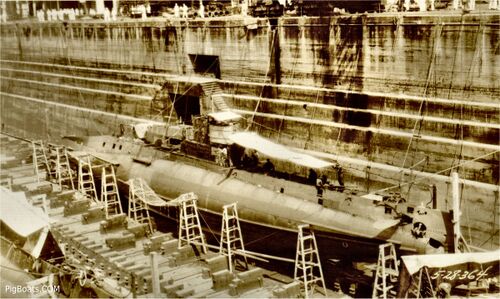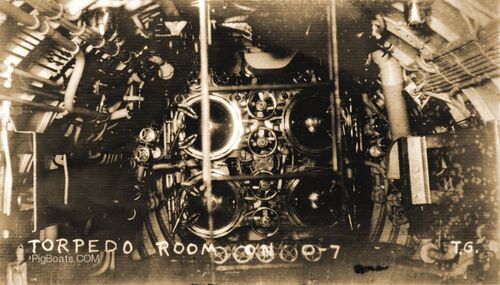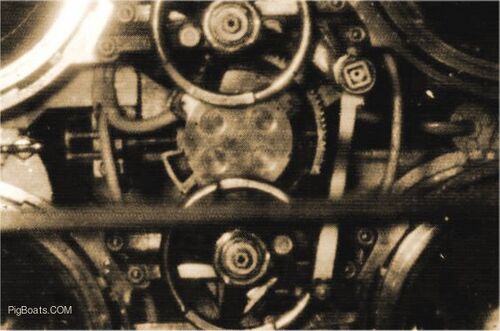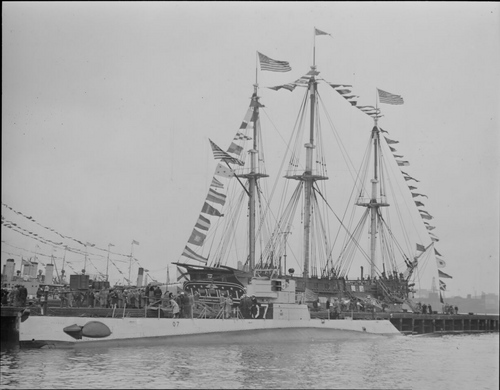O-7

Photo in the private collection of Ric Hedman

The O-7 in drydock. This was likely at the Philadelphia Navy Yard just prior to the attempted deployment of some of the O-class submarines to Europe. The date would have been late October, 1918.
The paint has been stripped from the aft end of the conning tower fairwater of the O-7, but the chariot bridge has either been painted or not had the paint removed. A number of access plates have been removed from the superstructure and the bow planes have been rigged out. The torpedo tube bow cap has been rotated slightly and the opening for a torpedo to fire through has been revealed and there is a line or hose leading into it. It is interesting to note the gesture to safety with the rigging of a net midships to catch men or other things from damage or injury if fallen or dropped. Between the second and third scaffolding "A" frames from the right, along the hull, closer the second, three sharp dents can be seen in the hull where the submarine had some close calls impacting something. Perhaps these were in the area of a tank and not threatening to the submarine.
In the lower left of the image the O-8 can be seen. About the only piece visible is the part with the O-8 letters on the superstructure. Part of the O-8's fore deck has been removed for work.
Photo in the private collection of Ric Hedman
-
"Swede" Hansen
-
Chief Gunners Mate Simmons
-
Harold "Frenchy" Blair
-
"Spick" Carroll
All photos courtesy of the NHHC.

O-7 at the pier at Submarine Base Coco Solo, Panama, 1923. Also seen here are the O-3 (SS-64) and the R-26 (SS-104).
Photo in the private collection of Ric Hedman

The torpedo room of the O-7. There is nothing to date the photo that we know of. Best we can say is mid 1920's. What is seen are the four torpedo tube breech doors photographed through the deck access ladder. Between the tube doors, the row of vertical wheels are the operators for opening and closing the tube outer doors for each tube. In the center of the column of handles you can see a shiny "disk". This was an indicator that showed the position of the bow cap openings. In earlier submarines this was rotated by hand and a large wheel would have been present in this location. But, by the time the mechanism was one highly geared shaft operated by a handle, seen on the right near #1 tube breech door.
The row of horizontal valve handles at the bottom, under the tube doors, are the tube drains for emptying the tubes after a torpedo has been fired and the outer doors have been closed so the inner doors can be opened. The water drained into a compensating tank, called that because the water drained into it made up (compensated) for the weight of the torpedo fired.
The submarine carried a total of eight 18-inch Bliss-Leavitt Mk 7 torpedoes. Four in the tubes and four reloads. Submarines of this and like classes were only expected to make patrols of 7 to 10 days. Operational limits were set by the size of the boat, the amount of fuel, food, and water carried so firing more than eight torpedoes wasn't to be expected. Torpedoes in the tubes could be withdrawn partially from the tubes to have maintenance performed on them.
To take a photo like this the shutter needed to be open a long time and there are several "ghosts" in the image where people moved in and out of the picture. Just above the word "Torpedo" is a dark blur. On the right side at the foot of the ladder where you should be able to see the leg of the ladder that leg disappears and so does half of the bottom rung of the ladder. An overhead light is making a blur at the top of the ladder.
The large tube at the upper left corner that leads forward, makes a sharp bend down then goes forward again, makes sharp bend in and stops is a speaking tube from the control room. In latter years this system was replaced by a low voltage telephone system.
Photo in the private collection of Ric Hedman

Between the tube doors, the row of vertical wheels, are the operators for opening and closing the tube outer doors for each tube. In the center of the column of handles you can see a shiny "disk". This was an indicator that showed the position of the bow cap openings.
When the bow cap turned to bring the cap openings over the tube muzzle doors the tubes uncovered would show up in color, (the color was red maybe) in the openings in this disk. One top and one bottom, diagonal from each other. The bow cap was rotated by the large handle to the right, hanging down.
Photo in the private collection of Ric Hedman
Remembrances of the O-7 by LCDR John Surprenant, USN (Ret.)
SN to QMCS 1943 to 1958; ENS to LCDR 1959 to 1973.
Boats served on: USS O-7 (SS-68), Tirante (SS-420), Greenfish (SS-351), Grouper (SS-214), Burrfish (SS-312), Barb (SS-220), Odax (SS-484), & George Washington (SSBN-598). He also did tours aboard the submarine tenders USS Proteus (AS-19) and Canopus (AS-34), plus some destroyer and tanker duty as well as two tours as an instructor at the Naval Submarine School.
"I was assigned to the O-7 coming out of sub school and waiting for a fleet boat. I was a TMSN out of torpedo school but decided I wanted to be a quartermaster and changed over.
The CO was a CDR Latham who had been skipper of Tautog (SS-199), and while I was on board he was relieved by LCDR Shutt. The C.O.B., (Chief Of the Boat), was a TMC named Corsey and I remember the leading QM was named McMillan.
While on board I received a set of orders to USS Escolar (SS-294) which was coming through New London but I was on leave and they took another QM3 from another O-boat. Escolar was lost on her first patrol. I later caught USS Tirante (SS-420) with skipper George Street who won the Medal of Honor.
The most thrilling thing about being a QM on board an O-boat was opening that single dog hatch with pressure in the boat while surfacing.
O-7 operated as a school boat for sub school students. We did daily ops out of New London most of the time. Once in a while we did an op up to Casco Bay, Maine. With our rather primitive water, heat, berthing etc. it was an adventure. For two weeks you never took your foul weather gear off and there were no showers. Berthing as I remember was all hands hot bunking which did not really matter as you were fully clothed anyway. Test depth as I remember was 170 feet and our CO CDR Latham tried it one time. We blew a couple of salt water connections and some zerk fittings flew out of the periscope grease connections.
I wish now that I appreciated the risk involved in that but I relived it when my Tirante skipper took us to 670 feet on a 400-foot test depth boat.
Some remembrances are the difficulty in opening the ballast tank flood valves. As a robust 18-year-old 130 lb. sailor I could barely do it.
The "conning tower" was really a tube from the control room to the bridge. When we surfaced it acted as a conduit for all the air in the boat and for the QM it was like being shot out of a cannon.
The after battery was also the messroom, no tables or seats. You got your chow on a tray and hunkered down and ate it--of course the engine room WT door was completely visible as was the hopper, (the toilet commode). If your timing was right you could watch a guy doing his business while you ate your lunch."

O-7 shown alongside the pier at the Boston Navy Yard, approximately 1930. The historic sailing frigate USS Constitution of War of 1812 fame is moored behind her on the other side of the pier. This could possibly be a Navy Day celebration, as there is a crowd on the pier and civilian visitors are coming aboard, and the Constitution is decked out in a plethora of signal flags and National Ensigns.
The aft superstructure skeg on O-7 has been cut away, and a portion of the upper edge of the rudder is barely visible. The portion of the skeg proved to be hard to maintain, with corrosion control being a major issue. The skegs were known to rust so badly that several boats reported them falling off at sea. Cutting away the unnecessary portion of the skeg was a measure taken to prevent this.
Photo courtesy of the Massachusetts Digital Commonwealth.
Page created by:
Ric Hedman & David Johnston
1999 - 2023 - PigBoats.COM©
Mountlake Terrace, WA, Norfolk, VA
webmaster at pigboats dot com




